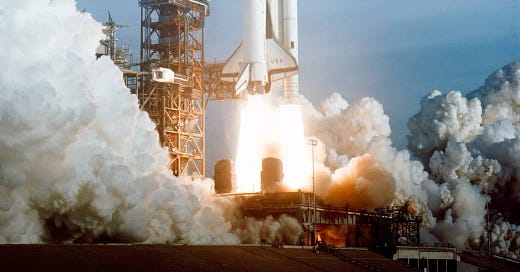This edition of Unbeaten Path was approved by Chris without edits. Am I getting better at writing, or he’s getting bored of me?
What scares many about hardware is how expensive it is to make errors. A generation of investors who grew in the software era is simply not ready to underwrite that risk. For years, startup-world has preached the “launch fast and iterate” way of thinking, which applies really well to software but not to hardware.
Unfortunately, many of the things that are worth building are made of atoms. Moreover, there is no one better suited to bring radical innovations to the market than startups. How to solve this apparent contradiction?
The way I rationalize this is by thinking about the risks a startup founder decides to take. For any given startup, there are essentially three risks: the technical risk, can you build the product?, the execution risk, can you bring it to the market?, and the market risk, does a market actually exist?
The startup storytelling has brought us to believe that the market risk is the first one to address - “build something people want”, start with a problem you are obsessed with, solve a pain you experience yourself, and many other beautiful VC clichès.
Truth is that, if you consider overall risk as a finite sum of market, technical, and execution risks, founders can decide to take some more market risk in exchange for reduced technical or execution risks. In a world in which the marginal cost of errors is negligible, and in which subsequent iterations reduce the risk of failure, a rational approach would be to take more market risk and less technical and execution risks: the former can be acted upon with a pivot, while the remaining two are strongly related to the skills, know-how, and personalities of the founders, which are harder to change. This is why early-stage investors say that all that matters is the founder, not the idea. What they are really saying is that they prefer to take market risk over other types of risks. This is kind of hilarious if you think about “build something people want” and how obsessed VCs are with product-market fit…
If this makes sense, it is because we started from the assumption that the marginal cost of error is negligible. Unfortunately, that doesn’t apply to hardware. If you are building chips, every tape-out costs in the order of millions and so it’s very expensive to commit errors. Same applies to rockets, energy production facilities, robots, and so on. In startups building atoms, the technical risk is particularly high and expensive to take; the bad news is that, albeit high, it might not be the dominant one. Unfortunately, many hardware startups need to build facilities and need to sell into high-impact industries where governments have a say and, more in general, exogenous risks come into play. Truth be told, this doesn’t apply exclusively to hardware but to anyone working with regulated industries. However, it can be particularly painful in industries where regulatory control can be stricter, like space, energy, or defense for example. For the sake of simplicity, I will put regulatory and exogenous risks into the bucket of “execution risks”.
How do the best founders deal with this problem? Total risk is the sum of technical, execution, and market risk, and if technical and execution risks are particularly high, the best way to minimize the total is not to take market risk at all.
Let’s look at an example.
Crusoe builds “Digital Flare Mitigation” systems, producing electricity using the gaseous by-products of crude oil extraction, that would otherwise be burned in a process called “flaring”. They could’ve tried to sell these systems to oil extraction companies, so that they could turn a polluting by-product into another source of revenue. This approach would’ve had a pretty high market risk: these companies are good at digging holes in the ground with heavy machinery, not at trading electricity. How would they store the electricity? Who would operate the system? Who would deal with the transmission of the electricity? What about pricing arbitrage? It’s a whole different job.
The founders took a different approach and decided to build custom, shipping container-sized, Bitcoin mining data centers. This certainly adds some technical and execution risk, as you now have to build in-house a whole new piece of hardware that requires a new skill set and convince the drilling companies that it’s worth having you there. If you accept this trade-off, the market risk disappears: Bitcoins are liquid assets that can be mined whenever and wherever it’s needed.
Once you look at the world with the “no market risk” lens, you realize it’s more common than it seems. As a matter of fact, no market risk very often means vertical integration, and vertical integration is a trick founders use when they build in frontier markets, or in markets dominated by slow and big incumbents. By going that way, you can offer a solution to the customers who have the biggest pain, and avoid long and painful sales cycles, trying to convince incumbents to innovate when all they want is to milk the cash cow.
One of the best quotes on this comes from Chris Power, Founder and CEO of Hadrian:
I realized that the right way to bring technology to the industrial space is not to sell software to these companies, it’s to build an industrial business from scratch with software.
It’s clearly a painful approach, to vertically integrate and build an industrial business instead of an asset-light SW business. But people like Power realized that avoiding market risk is, sometimes, the only recipe for success.



